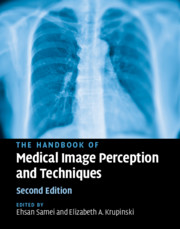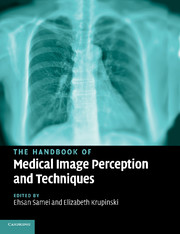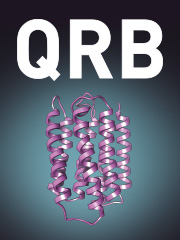The Handbook of Medical Image Perception and Techniques
A state-of-the-art review of key topics in medical image perception science and practice, including associated techniques, illustrations and examples. This second edition contains extensive updates and substantial new content. Written by key figures in the field, it covers a wide range of topics including signal detection, image interpretation and advanced image analysis (e.g. deep learning) techniques for interpretive and computational perception. It provides an overview of the key techniques of medical image perception and observer performance research, and includes examples and applications across clinical disciplines including radiology, pathology and oncology. A final chapter discusses the future prospects of medical image perception and assesses upcoming challenges and possibilities, enabling readers to identify new areas for research. Written for both newcomers to the field and experienced researchers and clinicians, this book provides a comprehensive reference for those interested in medical image perception as means to advance knowledge and improve human health.
- An overview of key techniques allows the reader to adopt these in their own studies
- A summary of the future of medical image perception enables identification of new areas of research
- Examples and applications demonstrate the role of information perception in multiple clinical disciplines
Reviews & endorsements
'In The Handbook of Medical Image Perception and Techniques, Samei and Krupinski have assembled a group of internationally-recognized experts to address an important but under-emphasized stage in the process of medical imaging.' William Hendee, Distinguished Professor Emeritus, Medical College of Wisconsin
'A concise text that offers a unique collection of chapters from all the leading authors in medical perception. I would highly recommend this text for anyone wanting to know more about medical perception from its historical perspective to current research. A must have reference for anyone wanting to join in this exciting discipline.' Lonie R. Salkowski, University of Wisconsin, Madison
'Drs Elizabeth Krupinski and Ehsan Samei have given us a wonderful new edition of their landmark textbook on medical image perception, with updated chapters throughout and with approximately thirty percent new material added since the first edition was published in 2010. This new volume comprehensively updates and extends the 'keystone' publication in the field of medical image perception research. Each chapter is the definitive reference on its topic, authored by a foremost expert. With this new edition, Drs Krupinski and Samei have assembled a compendium of what amounts to decades of research and accumulated wisdom in a compact package-comprehensive and yet still very accessible for a broad audience. … Anyone with an interest in this topic will find this book to be an invaluable resource.' Michael A. Bruno, Pennsylvania State University
Product details
December 2018Hardback
9781107194885
534 pages
283 × 225 × 28 mm
1.69kg
279 b/w illus.
Available
Table of Contents
- 1. Medical image perception Ehsan Samei and Elizabeth Krupinski
- 2. A short history of image perception in medical radiology Harold Kundel and Calvin Nodine
- 3. Spatial vision research without noise Arthur Burgess
- 4. Signal detection theory – a brief history Arthur Burgess
- 5. Signal detection in radiology Arthur Burgess
- 6. Lessons from dinners with the giants of modern image science Robert Wagner
- 7. Perception in context David Manning
- 8. Perceptual factors in reading medical images Elizabeth A Krupinski
- 9. Cognitive factors in reading medical images David Manning
- 10. Satisfaction of search in radiology Kevib Berbaum, Edmund Franken, Robert Caldwell, Kevin Schartz and Mark Madsen
- 11. Acquiring expertise in radiologic image interpretation Calvin F. Nodine and Claudia Mello-Thoms
- 12. The first moments of medical image perception Jeremy M. Wolfe, Karla K. Evans and Trafton Drew
- 13. Image quality and its clinical relevance Justin Solomon, Robert Saunders, Jr and Ehsan Samei
- 14. Designing perception experiments Ehsan Samei
- 15. Receiver operating characteristic analysis: basic concepts and practical applications Georgia Tourassi
- 16. Multireader ROC analysis Stephen L. Hillis
- 17. Memory effects and experimental design Tamara Miner Haygood and Karla K. Evans
- 18. Observer models as a surrogate to perception experiments Craig K. Abbey and Miguel P. Eckstein
- 19. Implementation of observer models Matthew A. Kupinski
- 20. Value and limitations of observer models Lucretiu M. Popescu
- 21. Perception of volumetric data Geoffrey D. Rubin, Trafton Drew and Lauren H. Williams
- 22. Performance assessment using standardized data sets: the PERFORMS® scheme in breast screening and other domains Yan Chen and Alastair Gale
- 23. Breast screen reader assessment strategy (BREAST): a research infrastructure with a translational objective Patrick Brennan, Lee Warwick and Kriscia Tapia
- 24. CAD: an image perception perspective Maryellen Giger and Weijie Chen
- 25. Common designs of CAD studies Yulei Jiang
- 26. Evaluation of CAD and radiomic tools Berkman Sahiner and Nicholas Petrick
- 27. Quantitative imaging – images to numbers Daniel C. Sullivan and Edward F. Jackson
- 28. Optimization of 2D and 3D radiographic imaging systems Jeffrey H. Siewerdsen
- 29. Display optimization from a physics perspective Alisa Walz-Flannigan and Scott Stekel
- 30. Display optimisation from a perception perspective Mark Mcentee and Rachel Toomey
- 31. Perception and training William F. Auffermann and Maciej Mazurowski
- 32. Ergonomics 2.0: fatigue in medical imaging Sian Taylor-Phillips, Chris Stinton and Elizabeth Krupinski
- 33. Perception issues in pathology Liron Pananowitz, Claudia Mello-Thoms and Elizabeth A. Krupinski
- 34. Medical image perception from a clinical perspective Francine L. Jacobson
- 35. Future of medical image perception Elizabeth A. Krupinski and Ehsan Samei.




